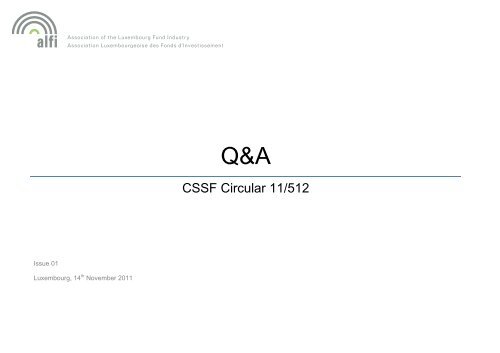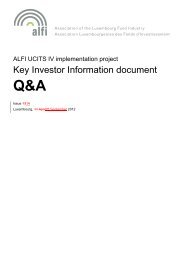Q&A on CSSF Circular 11/512 - Alfi
Q&A on CSSF Circular 11/512 - Alfi
Q&A on CSSF Circular 11/512 - Alfi
Create successful ePaper yourself
Turn your PDF publications into a flip-book with our unique Google optimized e-Paper software.
ALFI Q&A <strong>CSSF</strong> <strong>11</strong>/<strong>512</strong>Questi<strong>on</strong>sProposed Answersfurther explanti<strong>on</strong>s about the use of derivatives as part of theinvestment strategy/objective of a fund. The disclosure mayalso include important elements to put the leverage figure intoc<strong>on</strong>text, such as share class hedging and the types ofderivative instruments used as well as the collateral coverageof these.6. What is the level of documentati<strong>on</strong> required in secti<strong>on</strong> 1.6and 1.7 of the Appendix in <strong>CSSF</strong> <strong>Circular</strong> <strong>11</strong>/<strong>512</strong>, i.e. copiesof each informati<strong>on</strong> report at the date of financial year-endof the management company?<strong>CSSF</strong> <strong>Circular</strong> <strong>11</strong>/<strong>512</strong> prescribes in secti<strong>on</strong> III.1.1 that the RiskManagement functi<strong>on</strong> shall regularly report to the C<strong>on</strong>ductingOfficers / Board of Directors (and the supervisory functi<strong>on</strong> (ifapplicable) <strong>on</strong> the adequacy and effectiveness of the RMP.It is our understanding that, for the purpose of secti<strong>on</strong> 1.6 ofthe appendix of <strong>Circular</strong> <strong>11</strong>/<strong>512</strong>, practiti<strong>on</strong>ers shall provide<strong>CSSF</strong> with an example <strong>on</strong> the reporting of the assessment of: the adequacy, i.e. is the risk management processcovering all material risks based <strong>on</strong> the current productand financial instruments scope (e.g. risk limits, modelcoverage, etc); the effectiveness, i.e. proper performance of riskmeasurement as well as detecti<strong>on</strong> and escalati<strong>on</strong> of limitbreaches and outliers to the management and the BoD.<strong>CSSF</strong> <strong>Circular</strong> <strong>11</strong>/<strong>512</strong> prescribes in secti<strong>on</strong> 1.7 of the Appendixthat regular reports made by the risk management functi<strong>on</strong> ofthe ManCo are to be communicated to the <strong>CSSF</strong> at leastannually.5
ALFI Q&A <strong>CSSF</strong> <strong>11</strong>/<strong>512</strong>Questi<strong>on</strong>sProposed AnswersDue to the differences in scope, structure and frequency of theregular reports made by the various ManCos, the level ofdocumentati<strong>on</strong> may vary. It is our understanding that theManCo shall provide <strong>CSSF</strong> with examples of report(s) provingthat a holistic risk reporting is provided to Senior Management/Board of Directors.II. Questi<strong>on</strong>s related to Portfolio Risk Calculati<strong>on</strong>methods:7. Does the maximum potential loss approach menti<strong>on</strong>ed in<strong>CSSF</strong> <strong>Circular</strong> <strong>11</strong>/<strong>512</strong> in IV.4.1 (c<strong>on</strong>centrati<strong>on</strong> risk) beinterpreted in applying a Value-at-Risk figure?Paragraph IV.4.1. refers to the situati<strong>on</strong> where, for a specificFDI, the c<strong>on</strong>versi<strong>on</strong> of the FDI into the equivalent positi<strong>on</strong> inthe underlying asset (i.e., commitment approach) proves to beinadequate. In this case, the maximum potential loss linked tothe FDI shall be used as its exposure for c<strong>on</strong>centrati<strong>on</strong> risk inthe event of default by the issuer.It is our understanding that the VaR c<strong>on</strong>tributi<strong>on</strong> of anindividual FDI cannot be deemed to reflect the maximumpotential loss of that FDI.8. What risk categories should be included in the stresstesting?As part of a general requirement <strong>on</strong> risk measurement aManCo shall – where appropriate - c<strong>on</strong>duct stress tests andscenario analyses to address risks arising from potentialchanges in market c<strong>on</strong>diti<strong>on</strong>s that might have an adverseimpact up<strong>on</strong> the managed UCITS.6
ALFI Q&A <strong>CSSF</strong> <strong>11</strong>/<strong>512</strong>Questi<strong>on</strong>sProposed AnswersThis means in principle all risk categories relevant for a UCITSneed to be c<strong>on</strong>sidered in stress testing.UCITS that use the VaR approach (for market risk) mustc<strong>on</strong>duct stress tests. In additi<strong>on</strong>, the <strong>Circular</strong> makes referenceto stress tests for the modeling of the net subscripti<strong>on</strong> andredempti<strong>on</strong> flows with regards to the liquidity risk.As such, the stress testing could therefore focus both <strong>on</strong> themarket risk and the liquidity risk. The stress scenarios to beforeseen would cover the market movements impacting assetvalue and liquidity of positi<strong>on</strong>s. The combinati<strong>on</strong> with the stresstesting of subscripti<strong>on</strong> and redempti<strong>on</strong> flows provides arounded-up and c<strong>on</strong>sistent in terms of impact.Nevertheless, the proporti<strong>on</strong>ality principle as set out under the<strong>Circular</strong> does allow the UCITS to adapt its stress testingprocedures to the nature, size and complexity of theinvestment strategies and or investor base. Also, themateriality of the risks as determined in the ‘risk profile’ of theUCITS will be important to determine the scope of the stresstesting to be performed.The following criteria are likely to impact both the market andliquidity stress tests:Market price sensitivity per asset (class)Market size/trading volumeType of assetFair value pricing7
ALFI Q&A <strong>CSSF</strong> <strong>11</strong>/<strong>512</strong>Questi<strong>on</strong>sProposed AnswersFor further details, we refer to the <strong>CSSF</strong> circular <strong>11</strong>/<strong>512</strong> III.9. What is the use of the stress test results? The primary objective of stress test is to inform themanagement and the Board <strong>on</strong> plausible downside riskscenarios as well as to allow a plausibility check <strong>on</strong> the resultsof the VaR computati<strong>on</strong>. If stress test results provide anymaterial issues, the risk management functi<strong>on</strong> will also discussthose results with the relevant portfolio manager.The use of the stress test depends <strong>on</strong> the recipient:Board: assessment of downside risk and decisi<strong>on</strong>making <strong>on</strong> investment strategy adjustments for liquidityor market risk issues;Senior Management: periodic/<strong>on</strong>going review andassessment of adequacy of ST c<strong>on</strong>cept – in particular<strong>on</strong> liquidity and market originated tail risks and decide<strong>on</strong> necessary measures, report to Board <strong>on</strong> ST andnecessary measures (if needed); Risk Management functi<strong>on</strong>: periodic/<strong>on</strong>goingm<strong>on</strong>itoring of liquidity and market originated tail risks inorder to (i) prepare and suggest Board acti<strong>on</strong>s and (ii)plausibility check <strong>on</strong> the VaR model results.The stress test results are to be addressed with the portfoliomanagers in the light of corrective measures to avoid over- orunder-exposure (i.e. –performance). Such discussi<strong>on</strong>s can beled by the risk management functi<strong>on</strong> and the outcome is to bedocumented and part of the senior management and BoD8
ALFI Q&A <strong>CSSF</strong> <strong>11</strong>/<strong>512</strong>Questi<strong>on</strong>sProposed Answersreporting.10. For the case <strong>on</strong>e applies a commitment approach based <strong>on</strong>a durati<strong>on</strong> netting in line with <strong>CSSF</strong> <strong>11</strong>/<strong>512</strong> requirements<strong>on</strong>e also needs to c<strong>on</strong>sider ‘remaining FDIs’ not beingincluded in the durati<strong>on</strong> neeting. How shall this be d<strong>on</strong>e?The positi<strong>on</strong>s remaining open after the full durati<strong>on</strong> nettingapproach are to be included as durati<strong>on</strong> weighted positi<strong>on</strong>s inthe normal commitment approach. The final commitment is thesum of the durati<strong>on</strong> netted positi<strong>on</strong> plus the other FDIscalculated based <strong>on</strong> the commitment calculati<strong>on</strong> methoddescribed in the circular <strong>11</strong>/<strong>512</strong>.III.Questi<strong>on</strong>s related to reporting and delegati<strong>on</strong><strong>11</strong>. How can the reporting to the c<strong>on</strong>ducting officers vs. thereporting to the BoD look like?Adequate risk reporting is key for a risk functi<strong>on</strong> and inparticular for the Senior Management (i.e., C<strong>on</strong>ductingOfficers) of a ManCo to ensure they can comply with theirobligati<strong>on</strong>s and resp<strong>on</strong>sibilities of oversight.The extent and frequency of the reporting to C<strong>on</strong>ductingOfficers and the Board may vary depending <strong>on</strong> the structure ofthe RM functi<strong>on</strong> (e.g. is a separate Risk Departmentestablished) and the governance structures established withinthe ManCo itself (e.g. roles of BoD, CO, internal departments).Best practice proposals <strong>on</strong> reporting to C<strong>on</strong>ducting Officersand the Board:Ad-hoc reporting(CO) should be involved in the <strong>on</strong>-going oversight of the RiskManagement process and should act as the point of escalati<strong>on</strong>for any breaches of risk limits (i.e. ad-hoc reporting).9
ALFI Q&A <strong>CSSF</strong> <strong>11</strong>/<strong>512</strong>Questi<strong>on</strong>sProposed AnswersClear escalati<strong>on</strong> routes shall be used to escalate material RMissues first to c<strong>on</strong>ducting officers and, ultimately, to the Board.Regular reporting1. C<strong>on</strong>ducting Officers risk reportIn order to ensure that the CO (respectively a risk functi<strong>on</strong>)obtains the necessary informati<strong>on</strong> from the departments in theManCo as well as from outsourcing partners, a structuredbottom up reporting is needed.Based <strong>on</strong> the informati<strong>on</strong> received and the analysis performedby the (risk) department(s), a meaningful reporting to the COsis key to make risks transparent as well to propose and finallydecide <strong>on</strong> mitigating measures.The CO should receive regular reporting <strong>on</strong> risk management(e.g. weekly or m<strong>on</strong>thly) and the reporting should be holistic,i.e. entailing all risks categories identified.2. BoD risk reportThe Board shall receive a regular holistic risk report (e.g. <strong>on</strong> am<strong>on</strong>thly or quarterly basis) aggregating risk assessments, andincluding remedial measures taken that allows the Board toreceive informati<strong>on</strong> <strong>on</strong> the adequacy and effectiveness of therisk management process.The c<strong>on</strong>ducting pers<strong>on</strong>s and BoD may receive similarinformati<strong>on</strong> but with potentially varying level of detail – i.e.10
















